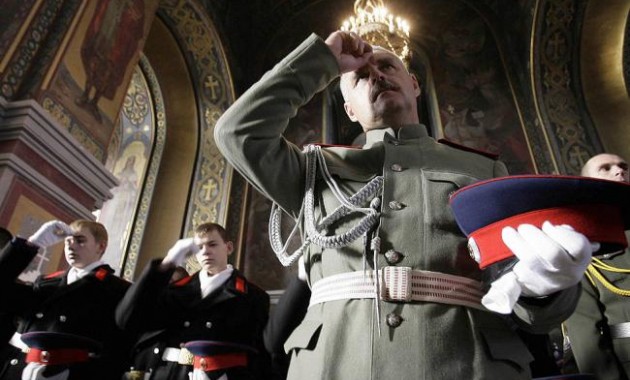
The Cossacks of Russia: Between Myth and Reality
Publication: Eurasia Daily Monitor Volume: 11 Issue: 157
By:

This week (September 7), more than 300 Cossacks, Russian Orthodox hierarchs, Moscow officials, and researchers assembled in the Russian North Caucasus city of Stavropol. They gathered to discuss the enormous and ever increasing gap between the way Cossacks are presented in the Russian and international media—and consequently viewed by the population—and the realities on the ground that few in Russia or elsewhere take the time to pay attention to. One speaker noted that Cossacks are seen by many Russians as either criminals or curiosities, when in fact, Cossacks today are among the most law-abiding—and in some ways are archetypes of the best features of Russian life (kavpolit.com, September 7).
The reasons for this gap lie in three areas: the nature of Cossacks as a historical community, their complicated relationship with the Russian and, especially, the Soviet state, and the rise of what many now call the neo-Cossacks in post-Soviet Russia. This latter group claims the name and seeks the privileges of pre-1917 Cossacks but, in fact, often has only the most tenuous connection with that past.
Wide debate persists about the origins of the Cossacks, although most accept the idea that the name has Turkic roots and means “free men,” a term that helps to explain part of the emergence of this group but far from all of it. Some Cossack ideologists argue that the Cossacks have roots extending back several thousand years, although most historians argue that they emerged only in the 14th or 15th century, as communities that formed first in opposition to and then as agents of various states in the Eurasian plain. These communities came into existence when groups of individuals fled from the growing power of the state into borderlands and then, in some cases, were transformed into forces under the control of those states—especially Russia—to extend their reach (Philip Longworth, The Cossacks, London, 1971; Tatyana Tabolina, Kazaki, Moscow, 1999).
By the end of the 19th century, there were 13 Cossack voiskas or “armies,” a term that referred not just to the military nature of Cossack society but to the entire community spread across the Russian Empire. They were extremely diverse. The most familiar, the Don, Kuban and Terek Cossacks, the so-called “triune unity,” were Christian Orthodox and saw themselves as defenders of the Russian imperial tradition as St. Petersburg extended its control over the Caucasus. But even these groups were more diverse than many think, absorbing non-Slavic and non-Orthodox communities.
Elsewhere, the Cossack “armies” were even more diverse, a reflection of the way in which they came into existence and the populations among which they lived. Some, such as the Semirechye Cossacks, had Muslims and Turks among their number. Others, such as the Transbaikal “army,” were primarily Buddhist. And still others, including the last formed in the Far East, were created as explicitly Russian Orthodox and Russian Imperial agents.
Not surprisingly given this variety, these groups had differing relationships with the Russian state. Many of them began their existence as refugees from that state and even opponents of the extension of its powers. Later they became a service stratum within it, a part of the Russian Imperial Army and a major source of support for the tsarist regime. But in the 20th century, this complexity had even more dire consequences for the Cossacks.
After the Russian revolution, Cossack units in the Don and Kuban were among the first to declare war against the Bolsheviks. They were rapidly followed by most others, including the Urals, Siberian, Transbaikal, Khabarovsk and Semirechye. Cossack units were among the very best soldiers the anti-Bolshevik White Armies had, fighting to the end and emigrating together as units. At the same time, however, there were Cossacks who, on an individual or village level, fought on the side of the Bolsheviks, as Sholokhov documented in his classic novel, “And Quiet Flows the Don.”
But Cossack opposition to the Soviets defined their experience in the 20th century. Although it is seldom mentioned by others, the Cossacks were the first ethno-national group to be subjected to repression by Vladimir Lenin and the Bolsheviks. They were nearly exterminated, their communal organizations were completely destroyed, and those few who tried to retain that identity were persecuted throughout the 1920s and 1930s. Cossackry survived largely as a distant memory and among the diaspora.
That changed briefly during World War II when Joseph Stalin was prepared to draw on any national tradition that would support his war against Adolf Hitler. Cossack units and themes were revived, but this was destined to be only a brief respite from Soviet repression, not only because of the freedom-loving nature of the Cossacks who represented a threat to Stalin’s totalitarian system, but also because many Cossacks living abroad fought on the German side in the hopes of overthrowing the Bolsheviks. At the end of the war, many of them were captured, their leaders hanged, and their followers sent to the GULAG.
By the late 1980s, Cossacks were little more than a curiosity for most people in the Soviet Union, something they had heard about from books and films but not a group they had any direct experience with. But with the Soviet Union’s disintegration, some Cossacks who had retained their identity sought to recover their past, to secure an official apology from the Russian state for what the Soviets did to them, and even to place themselves in the service of that state as helpmates to the police.
The number of people in this category was minute, thanks to Soviet repression, but they were quickly joined by others who saw in Cossackry a banner and even way of life they would like to emulate, especially if they could extract resources from the state and be treated as its honored supporters—in particular, as aides to the police. These are the “neo-Cossacks,” and they themselves claim to number upwards of three million people, although most experts say there are far fewer.
Given this diversity and this history, it is not surprising that Cossacks quite resemble the old story of the blind men and the elephant: observers can find evidence of almost anything they want, but what they find tells only part of the story. This combination effectively distorts, often in highly negative ways, what has been the history of a proud but much persecuted group living through difficult times.




